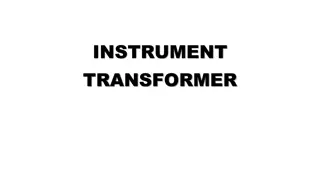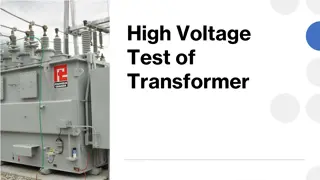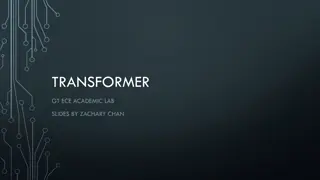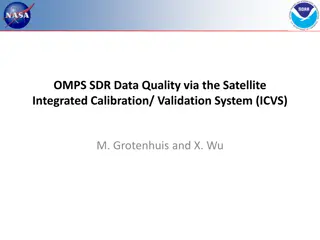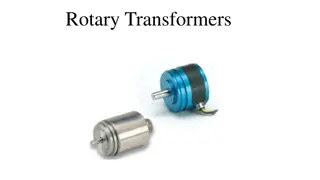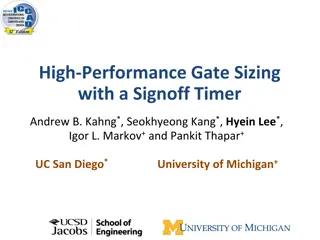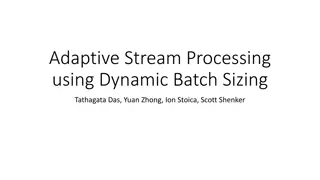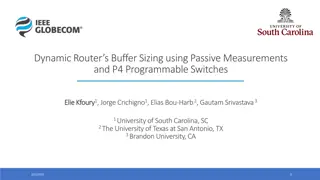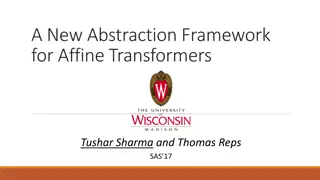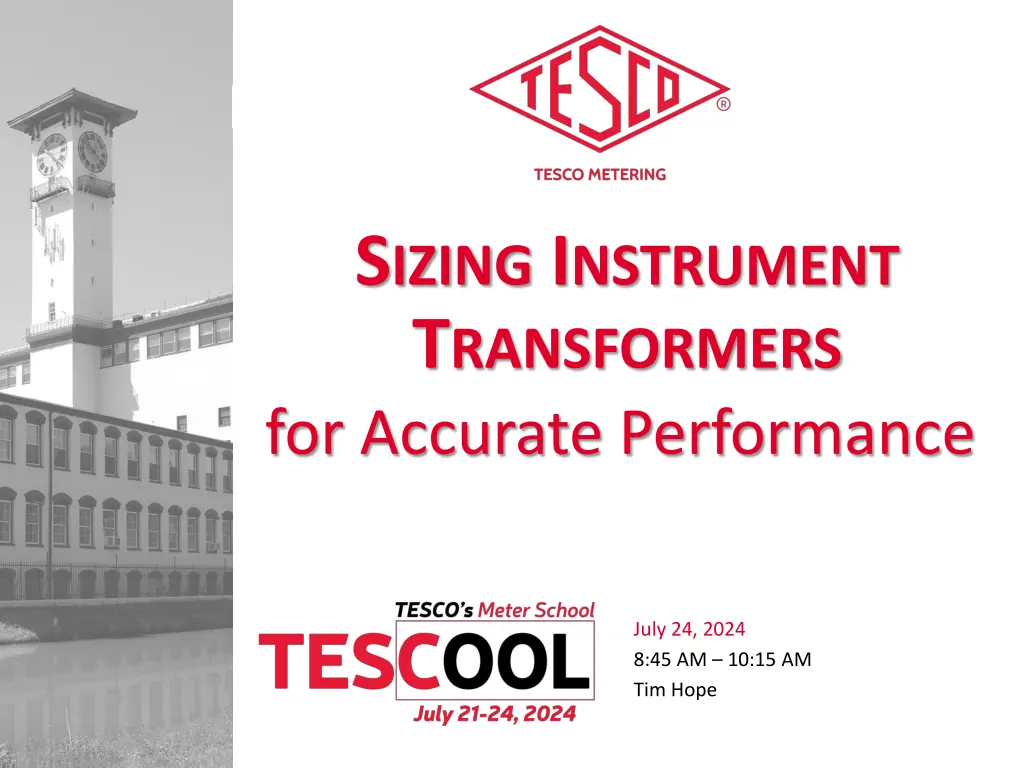
Instrument Transformers for Accurate Performance
"Learn all about instrument transformers, specialized devices designed for accurate measurement and control in electrical systems. Explore selection criteria, accuracy classes, rating factors, and more essential information for optimal transformer performance."
Download Presentation

Please find below an Image/Link to download the presentation.
The content on the website is provided AS IS for your information and personal use only. It may not be sold, licensed, or shared on other websites without obtaining consent from the author. If you encounter any issues during the download, it is possible that the publisher has removed the file from their server.
You are allowed to download the files provided on this website for personal or commercial use, subject to the condition that they are used lawfully. All files are the property of their respective owners.
The content on the website is provided AS IS for your information and personal use only. It may not be sold, licensed, or shared on other websites without obtaining consent from the author.
E N D
Presentation Transcript
SIZING INSTRUMENT TRANSFORMERS for Accurate Performance July 24, 2024 8:45 AM 10:15 AM Tim Hope
WHAT ARE INSTRUMENT TRANSFORMERS Specialized transformers designed to operate measurement and control devices: Voltmeters Ammeters Watthour Meters & Relays Transform high voltage or high current to lower values. Watthour meters may handle up to 320 amps and 480 volts. IT's transform with a high degree of precision. Also used to isolate high voltage or high available fault current from both the operator and end devices. tescometering.com 2
IT SELECTION CRITERIA Nominal System Voltage Basic Impulse Level Environment Accuracy Class VT Considerations Burden Type of Circuit & Connection Physical mounting requirements Fusing CT Considerations Burden Physical mounting requirements Expected Load Current Overcurrent Capability tescometering.com 3
IT SELECTION CRITERIA Nominal System Voltage The insulation class is based on phase to phase voltage Basic Impulse Level IT BIL must match or exceed the System BIL. Caution: More than one BIL may be available for a given Nominal System Voltage. Environment Indoor or Outdoor installation. Contaminating atmosphere. High Altitude (Over 3300 feet above sea level, derate transformer insulation) tescometering.com 4
IT ACCURACY CLASS Accuracy Classes define an envelope of ratio accuracy and phase angle accuracy for defined burdens. Separate accuracy envelopes are defined for Current Transformers and Voltage Transformers. ANSI C57.13 defines 3 levels of performance: 0.3 Revenue Metering 0.6 Indicating Instruments 1.2 Indicating Instruments Accuracy is defined for load power factors from 1.0 to 0.6 lagging. VT Accuracy performance from 90% rated voltage to 110%. CT Accuracy large performance envelope from 10% of rated current to rated current. smaller performance envelope from rated current to rating factor. tescometering.com 5
CT RATING FACTOR Maximum Expected load current should approach the Thermal Rating Factor of the CT. Rating Factor Example: 75:5, RF 3.0 @ 30 C maximum expected primary load current = 225 amps, and maximum expected secondary meter current = 15 amps, assuming that ambient temperature does not exceed 30 C. tescometering.com 6
CT RATING FACTOR Maximum Expected Load Current Rating Factors are used to keep transformer winding temperatures below 85 degree C. Rating Factors may be given for: Outdoor applications Indoor applications Rating Factors may be adjusted for ambient temperatures other than 30 and 55 degree C. 30 degrees C ambient 55 degrees C ambient ( ( ) ) 2 New RF @ New Ambient 85 New Ambient = ( ) 2 55 degrees rise Stated RF at 30 C tescometering.com 7
TYPICAL CT APPLICATION RANGE ANSI C57.13 0.3 Accuracy Class .60 .30 Percent Error Transformer Correction Factor will plot within this envelope .15 -.15 -.30 -.60 1% 5% 10% 50% 100% RF Percent of Rated Current tescometering.com 8
STANDARD 0.3 ACCURACY CLASS 0.6% Accuracy from 10% to 100% of rated current IEEE C57.13 Accuracy 0.3 @ BX.X; RF = X.X 0.60 0.3% Accuracy from 100% rated current up to RF Typical 0.3 CT Performance Curve Accuracy Class - % 0.30 10% 100% 0.30 No accuracy guaranteed at current levels less than 10% 0.60 Rating Factor 1.0 RF tescometering.com 9
IT CATALOG SHEET JAB-0C Grecian Urn 600 Volt CT tescometering.com 10
IEEE CT METERING ACCURACY Example 1: 0.3 accuracy CT, 200:5, RF 4.0 (Standard) 200 amps (rated amps) to 800 amps (RF 4.0) = 0.3% accuracy 20 amps (10% of rated amps) to 200 amps (rated amps) = 0.6% tescometering.com 11
APPLICATION EXERCISE A commercial building is being built with a 4-wire wye main service, rated for 200 A at 12,470/7200Y. Your boss wants you to meter the building with an electronic polyphase watt-hour meter. The initial load is expected to average about 1000 kW, but may peak to 2000 kW on occasion. Select the best CTs And PTs for the job NSV BIL Type Ratio tescometering.com 12
CURRENT CALCULATIONS Expected Current = 1,000,000W/7200volt x 3 Expected Current = 1,000,000W/(12,470volt x 1.732) Expected Current = 46.3 amps Peak Current = 2,000,000W/7200volt x 3 Peak Current = 2,000,000W/(12,470volt x 1.732) Peak Current = 92.6 amps tescometering.com 13
HIGH ACCURACY CT APPLICATION RANGE ANSI C57.13 0.3 Accuracy Class Extended Range to 5% of rated current .60 .30 Percent Error .15 High Accuracy Performance Standard -.15 -.30 Typical Range of Actual Load Currents -.60 1% 5% 10% 50% 100% RF Percent of Rated Current tescometering.com 15
QUESTIONSAND DISCUSSION Tim Hope Alabama Power This presentation can also be found under Meter Conferences and Schools on the TESCO website: tescometering.com ISO 9001:2015 Certified Quality Company ISO 17025:2017 Accredited Laboratory tescometering.com





